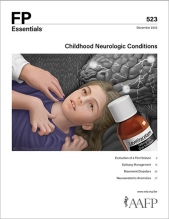
This clinical content conforms to AAFP criteria for CME.
Epilepsy is the most common neurologic condition in children and is characterized by recurrent unprovoked seizures. Epilepsy can be diagnosed after a first unprovoked seizure if characteristic clinical and electroencephalographic features suggest a high risk of future seizures. Epilepsy is classified based on seizure type, underlying causes, and potential electroclinical syndromes. This classification guides management and predicts its effectiveness. Some epilepsy syndromes resolve spontaneously (ie, are self-limited) or improve with management (ie, are pharmacoresponsive). Syndromes that contribute to intellectual disability, referred to as developmental and epileptic encephalopathies, are not self-limited, are unlikely to improve with management (ie, are pharmacoresistant), and are associated with poor long-term outcomes. Antiseizure drugs are the mainstay of epilepsy management. Some broad-spectrum drugs are used to manage multiple seizure types, and others have indications for specific seizure types or epilepsy syndromes. Dietary therapy, surgical resection, and neuromodulation may be options if drugs do not control seizures. Neurodevelopmental and mental conditions are common in children with epilepsy. These include intellectual disability, learning disabilities, autism spectrum disorder, attention-deficit/hyperactivity disorder, depression, and anxiety. Patients with epilepsy should undergo screening for these associated conditions as part of routine care. Physicians should instruct caregivers and family members on how to manage seizures, including use of rescue drugs.
Subscribe
From $350- Immediate, unlimited access to FP Essentials content
- 60 CME credits/year
- AAFP app access
- Print delivery available
Edition Access
$44- Immediate, unlimited access to this edition's content
- 5 CME credits
- AAFP app access
- Print delivery available
